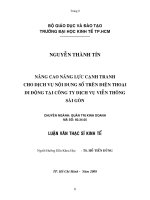Bài giảng Cơ sở dữ liệu nâng cao Chapter 6 Data replication
Bạn đang xem bản rút gọn của tài liệu. Xem và tải ngay bản đầy đủ của tài liệu tại đây (321.43 KB, 11 trang )
Data Replication
Overview of Replication
SQL Server replication is a set of technologies for:
copying and distributing data and database objects
from one database to another.
Then, synchronizing between databases to maintain
consistency.
Types of replication:
Snapshot replication.
Transactional replication
Merge replication
Peer – to – peer replication
Oracle Publishing replication
All of these types rely on a number of standalone
programs – agents.
Replication Scenario
Replication is analogous to the publishing industry
Article:
a database object that you want to replicate; it can be a
Table, View, or Store procedure, or other objects.
Publication:
A collection of articles.
One article can be in one or more publications.
Publication can be treated as a logical grouping for the
articles
For example: To replicate only the employee master
data, you can include employee table article, address
article, and any other relevant views to the publication
Replication Scenario
Subscription:
A request for a copy from the publication.
Define where to receive the publication, what the
frequency for the receiving is, …
Publisher
A database instance that holds publications for other
database instances to receive.
There can be several different types of publication in
one publisher.
Replication Scenario
Distributor:
Each publisher has a distributor to store replication
status data, and metadata about the publication.
Sometimes the distributor acts as a data queue for data
moving from the publisher to the subscribers and vice
versa.
There are two types of distributors:
local and remote.
Local distributor is where the publisher and distributor are in
one database server instance.
Subscriber:
A database instance that receives replicated data from
the publisher.
In some replication types the subscriber also passes
data to the publisher.
Replication Types
Snapshot:
Distribute data as it appears in the publisher at a
specific moment of time. Whenever the Subscriber
called for subscription, it will send the snapshot of the
current Publisher and send it to the Subscribers.
Limitations for using Snapshot Replication:
Replicating a small volume of data.
Infrequently changing data
Snapshot replication does not require primary article tables
Replication Types
Components in Snapshot Replication:
Two agents are used in Snapshot Replication, snapshot
and distribution.
Snapshot Agent:
A shared agent for all replication types.
The snapshot agent’s job is to generate data scripts for the
objects you are replicating.
These scripts are written to a folder in the file system called a
snapshot folder.
Distribution Agent:
This agent will read from a snapshot folder and distribution
database to propagate to the subscriber end.
Replication Types
Transactional:
The most used replication type
The most valuable feature of the transactional
replication is the ability to replicate incremental
changes rather than applying the all-data set.
Use transactional log to generate transactions for
replication.
Here are the scenarios where you can use transactional
replication:
Replicate huge volumes of data
For real-time application
Replicate data between non-SQL Server databases
Replication Types
Transactional:
The most used replication type
The most valuable feature of the transactional
replication is the ability to replicate incremental
changes rather than applying the all-data set.
Use transactional log to generate transactions for
replication.
Here are the scenarios where you can use transactional
replication:
Replicate huge volumes of data
For real-time application
Replicate data between non-SQL Server databases
Replication Types
Peer-to-Peer Replication
Peer-to-peer replication is an option with transactional
replication
All nodes in a peer-to-peer replication topology
subscribe and publish from and to all other nodes. A
transaction originating at one node will be replicated to
all other nodes, but not replicated back to originator.
This replication model is intended for use in
applications to have multiple databases or database
servers participating in a scale-out solution.
Replication Types
Merge Replication
Start from the initial snapshot. Afterward, changes at
both publisher and subscriber(s) are tracked with
triggers.
Subsequent data changes and schema modifications
made at the Publisher and Subscribers are tracked with
triggers.
The Subscriber synchronizes with the Publisher when
connected to the network and exchanges all rows that
have changed between the Publisher and Subscriber
since the last time synchronization occurred.









